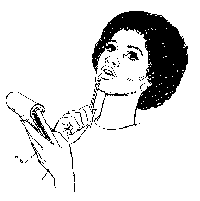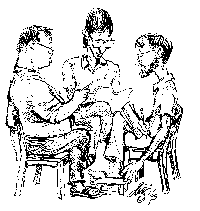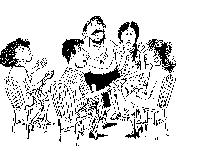Producing information materials presents a number of problems. The information typically comes from many different sources. The materials must be accurate and supported by scientific research or field experience, and they must be relevant to the needs of the audience. To be effective, the materials typically need to be simply written, well-illustrated, and carefully laid out.
However, many information materials, particularly those written by scientists, do not fulfill these criteria. They draw information from only a few sources. They are scientifically accurate, but may not be relevant to the needs of the audience. Many such materials are not simply written, and they contain few, if any, illustrations. Therefore, they are not effective.
Information materials can be produced in various ways.
- By a single author
- By a small team of writers
- By multiple authors who submit manuscripts to an editor
- Through a process analogous to journalistic reporting
- Through a conference or symposium
- Through a "writeshop"
Below is a brief description of each of these processes.
Single author
The single-author approach is the most usual method of preparing information materials. One person reviews the literature, draws on his or her own experiences, and writes the manuscript. This is then edited and laid out by an editor and desktop publishing specialist.
- This approach allows close control of the manuscript by one person. He or she decides what to write and how it is to be presented.
- The author must have a broad knowledge of the subject area. But it is unlikely that he or she has direct experience of all there is to know about the subject. The author must rely on information that is already written in the literature.
- The single author needs a lot of time to write the manuscript, check facts, and develop illustrations. It may take years for the author to complete a lengthy manuscript.
- The single-author approach is suitable for certain types of topic: where a single expert can develop a sufficient grasp of the subject, and has sufficient time to write the manuscript.
Small writing team
The small-team method is frequently used by academics to write textbooks. A small team of 3-4 people reviews the literature and writes the manuscript. Because several people with different (but overlapping) areas of expertise are involved, the coverage of the subject matter can be more comprehensive and the writing process made faster and less burdensome on each person.
- The small-team approach requires coordination and editing to ensure uniformity.
- The authors still need much time; it can still take years to develop a manuscript.
Multiple authors and editor
Many books are edited by a single person (a specialist in the field), but a different author writes each chapter. The editor selects the authors and invites each to contribute a chapter on his or her area of specialization. The editor provides guidelines on the content and style of each chapter. The authors write and submit their manuscripts, which the editor then revises to ensure that the style is uniform and there is not too much overlap or contradiction among chapters. The editor checks the revised version of each chapter with the author before the book is published. The editor may also write the introduction and one or more of the chapters in the book.
- This approach often takes a long time because the authors delay submission or revision of the manuscripts.
- The manuscripts may vary considerably in style and quality from author to author.
- There is limited opportunity to check each chapter with other specialists in the subject area.
Reporting
A "reporter" (a writer with a background in the subject matter) interviews key individuals, reviews the literature, and writes the manuscript. This approach is useful if the subject matter is not highly technical, and where the resource persons (e.g., scientists) do not have the writing skills to translate their experiences and ideas into a form that the audience (such as farmers or extension workers) Writing1.gif (2125 bytes) can understand easily. This approach is often used by prominent people (such as politicians) who hire "ghost writers" to interview them and write their thoughts down for publication.
- This approach needs a reporter who is knowledgeable in the subject matter. He or she needs to know what subjects to include, whom to interview, and the right questions to ask.
- Although the reporter is a skilled writer, this approach still needs a significant amount of time before the manuscript is completed. It must be double-checked with the sources to ensure that the reporter has not made any errors.
Conference
An organization (usually a university, research institute or professional association) hosts a conference and invites specialists in the subject area to present papers. The specialists write their manuscripts, bring them to the conference and present them. There may be time for a few questions or comments from the audience, allowing some peer review of each manuscript.
Sometimes an editor may be present during the conference and can discuss the manuscripts with the authors. The editor then edits the manuscripts and contacts the authors again to check any questions that arise. The editor then puts these manuscripts into a conference proceedings.
Convening a conference is relatively expensive because of the airfares, board and lodging and (sometimes) per diem expenses.
The manuscripts are not uniform; the quality and topics may vary considerably.
Because of the difficulty in contacting authors afterwards, the editing process can take a long time.
Writeshops
A writeshop is a very intensive process aimed at bringing together authors, editors, artists and desktop publishing specialists to produce a publication in a very short time. The subject area must be divided into topics and assigned to individual participants. Each participant prepares a manuscript according to guidelines, and brings this to the writeshop.
The participants present their manuscripts in turn. The manuscripts are critiqued by the other participants and revised by the author together with a team of editors. An artist draws pictures to illustrate the manuscript, and it is then desktop published to produce a second draft.
The process is then repeated with the second draft: presentation, editing, artwork revision, and desktop publishing. In a 2-week writeshop, it is possible to produce near-camera-ready material for a 200-page extension manual containing up to 100 separate topics.
- Writeshops are suitable where a large number of people know a little, but no-one knows a lot about the subject.
- They are suitable for preparing illustrated materials that present relevant, practical information in simple language — such as extension materials.
- The writeshop process is flexible; it can be modified and adapted to suit individual situations.
- Materials can be produced in a very short time. With suitable preparation and for some subjects, it is possible to produce material ready for the printer within a few days after the end of the writeshop itself.
- The writeshop brings together different groups — scientists, extension personnel, NGO staff, policymakers, farmers — to develop and produce a common set of materials. The participants benefit from the discussions and networking that result.
- The process enables comments and revisions from other participants (analogous to the peer review in conferences). Several authors can contribute to each section of the materials.
- If members of the intended audience (farmers, extensionists...) are present, the writeshop allows them to contribute to the preparation of the materials. The workshop itself enables a certain amount of pre-testing of the materials.
- However, the writeshop process is relatively expensive (since the host must cover food and board, airfares, staffing and possibly per diems).
- The process is very intensive; the time is sometimes not sufficient, and the process places a high demand on the abilities of the editors and other staff. A few participants may complain that their manuscripts have been revised too much.
- Writeshops are not useful for lengthy literature reviews or the presentation of detailed information.
Writeshops have been used to generate a wide range of information materials in various countries. Click here for more details on the writeshop process.
Short, 1-4 day writeshops can be used to develop first drafts of information materials. The participants need to bring information and ideas with them, but do not have to do any writing beforehand. At the writeshop, a team of editors guides the participants through the writing process. Artists draw illustrations for each manuscript. After the writeshop, the editor edits the manuscripts (and incorporates the artwork) and contacts authors to check any questions.
- Such writeshops are best suited for subjects where each participant has information on a separate, specific topic. They are less appropriate where there authors have a large degree of overlap and need to confer intensively with one another.
- The topics must be fairly similar in structure and treatment; this allows the editor to guide many people through the writing process at the same time.
- In a short writeshop, most participants can write only a few pages. Longer, more complex topics have to be divided into smaller parts, or a group can draft a manuscript that can be edited later into a publishable form.
